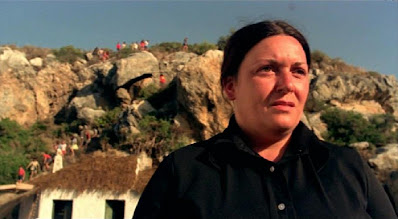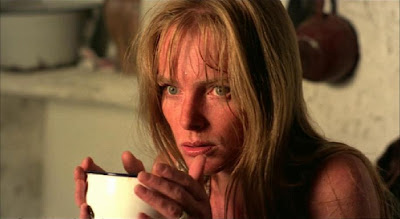... aka: Hex Massacre, The
... aka: Island of Death
... aka: Island of the Damned
... aka: Killer's Playground, The
... aka: Trapped
... aka: Who Can Kill a Child?
... aka: Would You Kill a Child?
Directed by:
Narciso Ibáñez Serrador
A nearly ten-minute-long opening credits sequence takes a disturbing and grim look at war. We see footage taken during World War II, the Indio-Pakistani War, the Korean War, the Vietnam War and the Biafra War in Nigeria. The number of casualties in each instance is shown for us; both the total number of deaths directly caused by the war and the number of victims that were children. In each instance, children comprise at least 50 percent of the total victims, sometimes as high as 75 percent. Needless to say, war is strictly an adult venture. Children do not start wars, nor do they ask for it or want it, yet they are perhaps the most vulnerable of all to war and its after-effects. A few thousand children may have survived being singled out for medical experiments in Auschwitz, for instance, but many more died after the war from things like acute anemia and tuberculosis. Children are more susceptible and vulnerable to the fallout from war as well; the famine, the spreading of disease, the lack of money and resources to medically care for the injured or sick... Hard-to-shake images of children suffering, starving, injured, missing limbs, burned by napalm, dying, or dead and covered in flies or being bulldozed into an open grave splash across the screen during this documentary intro accompanied by the haunting sound of children singing and humming. With this, Who Can Kill a Child? establishes its case for children having a grudge against us adults.
In the small Spanish village of Benavis, a female corpse - the victim of multiple stabbings - washes up on a crowded beach one fine sunny day. Soon after, a couple of British tourists - biologist Tom (Lewis Fiander) and his pregnant photographer wife Evelyn (Prunella Ransome) arrive there on vacation. Some kind of street festival is taking place but they aren't really there for that. They find a room, find a place to rent a boat and plan on heading out to the secluded Island of Almanzora - a place Tom had visited twelve years earlier - the following day. Since it's a four hour boat ride and a sparsely populated place of just a few hundred, very few tourists actually venture out there any more. The tide however does manage to carry lots of debris over from there... like a second corpse later that day. Tom and Evelyn go to see a fireworks show and discuss Fellini's LA DOLCE VITA. After learning it features a character who kills his own children so they won't suffer from the mistakes he's made, the wife labels the director "A fascist just like Mussolini."
The following day, Tom and Evelyn get on their boat and head out. Upon arrival, they encounter a few children hanging out by the pier. One little boy fishing refuses to let Tom see what he's using for bait. They venture inland and discover that a cafe, a bar, a store, a church and seemingly all of the homes are completely uninhabited. Aside from the few children they've already seen and a few others who pop from time to time. The kids usually refuse to talk to them and often just run away whenever they spot them. The only real interaction they have with the children is when a little girl wants to feel Evelyn's pregnant belly and listen to the baby's heartbeat. Afterward she does what most of the other kids do, laughs and then takes off. The couple stop by a boarding house and also find no one running the place. And then they see an old man getting beat to death with his cane by a little girl. Tom takes the body to a barn and then sees the children stringing it up, taking a long stick with a scythe fastened to the end and playing a bloody game of piñata.
One adult survivor who witnessed his wife getting murdered is eventually found hiding out in an attic and recounts what had happened there. Just two nights before Tom and Evelyn arrived, all of the island's children had woken up at the same exact time, began entering houses and slaughtering all of the adults one by one; laughing all the while and treating the whole thing like one big party. The man is eventually killed himself and so is a female Dutch tourist (some little boys then strip off her clothes in a church). There's no phone going out to the mainland anywhere on the island and every time Tom and Evelyn attempt to go to the pier to get a boat, an army of children line the streets. Tom and Evelyn manage to get to a jeep and head over to the other side of the island looking for help, but they're soon swarmed by the killer kids. Will the couple have to resort to violence against the children in order to save their own asses?
No fantasy-based explanation is given as to why all of the kids on the island have turned into killers. There is no toxic chemical spill, aliens have not taken over their bodies and they're not possessed by evil spirits. They've simply woken up one day with the desire to eliminate all adults and that's that. The intro and several other moments give us a hint as to why: They've basically grown tired of being abused, killed and mistreated by adults. Perhaps the children are evolving instinctually to what's gone on in the past and are sick of always being victims. The film works quite well metaphorically on those terms alone. It's well-made, fairly well-acted, nicely photographed (primarily in broad daylight), offers up numerous surprises and, despite a runtime of nearly 2 hours, manages to maintain interest throughout.
Released theatrically in the U.S. under no less than three different titles; simultaneously as Island of the Damned and Trapped by American International Pictures and later re-issued The Hex Massacre, this went into hibernation for a number of years (there was no legitimate American VHS release [at least to my knowledge] for a very long time). The film's reputation as a neglected mini-classic picked up some steam upon the 2007 release of the Dark Sky DVD, which includes a couple of documentary featurettes; one an interview with the director (who also adapted Juan José Plans' novel "El juego de los niños" / "The Children's Game") and another with cinematographer José Luis Alcaine (who'd later become the trusted cinematographer of Pedro Almodovar).
★★★1/2
























Sounds intriguing! Wasn't there a Japanese film made in the '60's with a similar plot? I seem to remember reading something like that. Maybe I'm just mixed up!
ReplyDeleteNot that I'm aware of but that doesn't mean there isn't! :)
ReplyDeleteThere's always confusion over the alternates for this one but
ReplyDelete"Lucifer's Curse" isn't this film, it's "The Chosen"/"Holocaust 2000". It played as "Lucifer's Curse" on a double feature with this film (as "The Hex Massacre" and "Hex") and somehow the MPAA got the two switched in their database so sometimes you'll see them applied to wrong film.